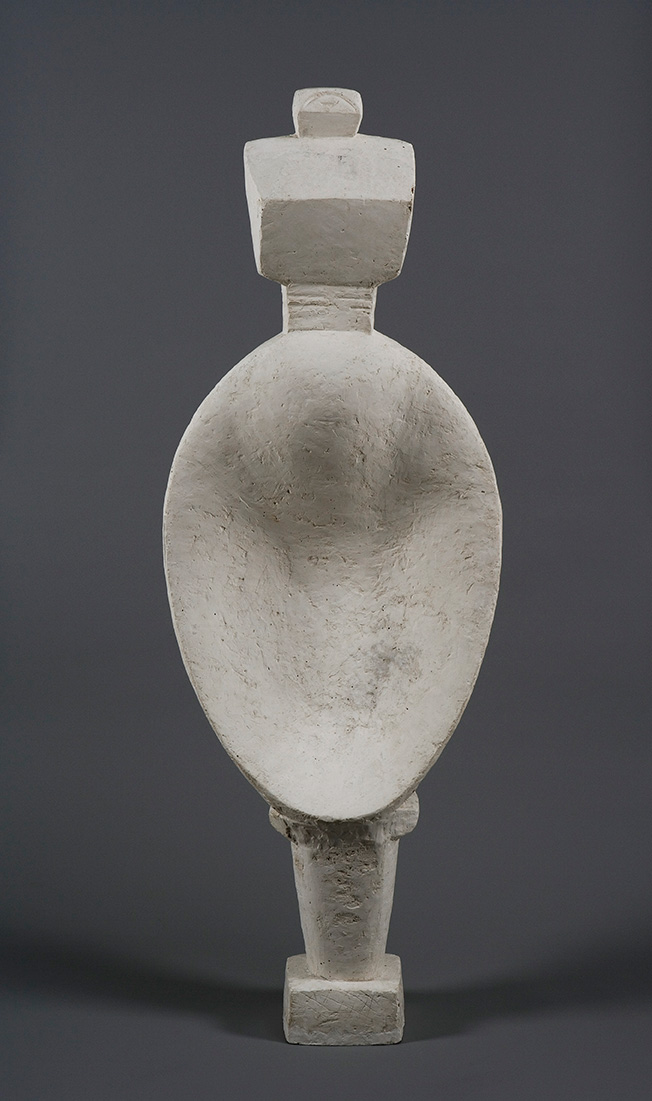
Spoon Woman (Femme cuillère), 1927
“I am very interested in art but I am instinctively more interested in truth [...] The more I work, the more I see differently”. [1]
At the age of 14, Alberto Giacometti (1901–1966) sculpted the bust of his brother Diego in his father’s studio, and shortly afterwards he produced his first oil painting, Still Life with Apples. When he was 20, he went to Paris to study under the master sculptor Antoine Bourdelle at the Académie de la Grande Chaumière. There he took part in the cultural effervescence of the first avant-garde art movements, and he discovered the artistic production of the Greeks and of non-Western peoples.
From 1925 to 1965, Giacometti’s artistic output ran parallel to the movements of modernism: Cubism, Surrealism, Abstraction, and the later return to Figuration. Throughout this period, his work explored spirituality by taking the human figure as a symbolic synthesis of the human condition. Giacometti acquired an interest in African art in 1926, an influence that was nothing new for the modernist artists of the previous generation like Picasso and Derain. At the Louvre in Paris, Giacometti also saw the classical Greek statuary from the Cyclades, which impelled him to explore the relationship between sculpture and plane. He also frequented the Ethnographic Museum and was an assiduous reader of avant-garde journals like Cahiers d’Art and Documents, which reflected the taste of the period for non-Western art.
In 1927, these influences were synthesized in Spoon Woman. Created in plaster and later cast in bronze, Spoon Woman is the monumental piece of this period. In this figure, Giacometti interprets the geometry characteristic of Cubism, the stylized forms of African art, and the formal simplicity of European modernism. With a large concave abdomen evoking the female uterus, the sculpture, inspired by the anthropomorphic ceremonial spoons of the Dan culture of Africa, constitutes a tribute to fertility.
Non-Western art had a lasting influence on Giacometti’s production, permitting him to move away from academic naturalism toward a totemic vision and a representation of the human being that was charged with magical interpretations. In this work, Giacometti also explores the metaphor of the ceremonial spoon.
Preguntas
Look closely at this work by Alberto Giacometti. What do you think this sculpture represents? What draws your attention about it?
Its name is Spoon Woman. How well do you think the title goes with the sculpture? Is there any way it doesn’t fit? Why not? What other figures or characters might it represent? If you could change the title, what would you call it?
Consider the practical aspects. If it were a spoon, what advantages or disadvantages would it have when compared with normal spoons? What would the knife and fork accompanying it look like? You can draw them and then show them to the rest of your group. What similarities and differences do you find among your different designs?
Why do you think the artist has interrelated the forms of a spoon and a woman? How would the sculpture change if it were meant to refer to the figure of a man?
From the mid-1920s, Giacometti and many other artists, like Pablo Picasso, Man Ray, and Constantin Brancusi, became fascinated with the exploration of African art. Search online for images of works by these artists, writing “African art” next to the name of the artist in the search engine. Why do you think these European artists took an interest in exploring the art of non-Western peoples? What might they have gained for their art from their discovery of these African objects? How would these ideas have been spread among the intellectuals of the time?
